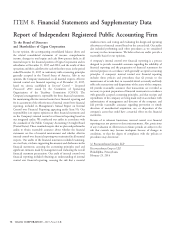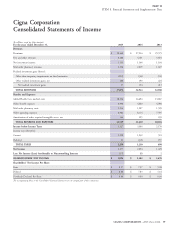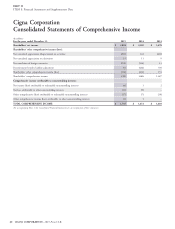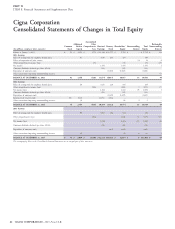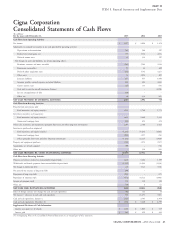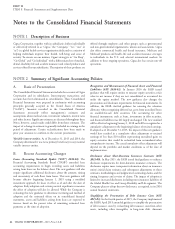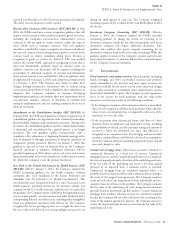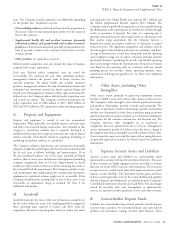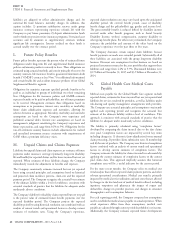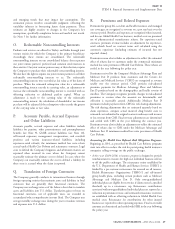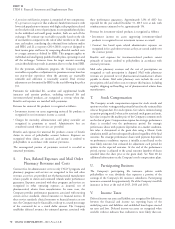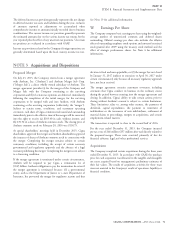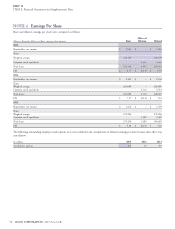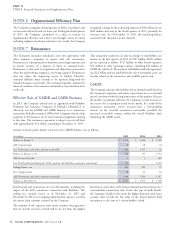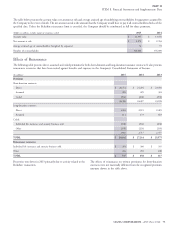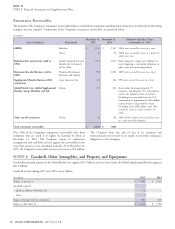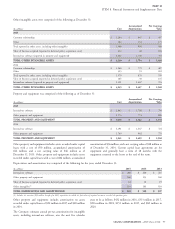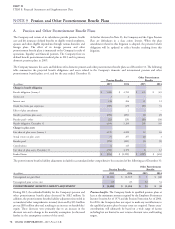Cigna 2015 Annual Report Download - page 98
Download and view the complete annual report
Please find page 98 of the 2015 Cigna annual report below. You can navigate through the pages in the report by either clicking on the pages listed below, or by using the keyword search tool below to find specific information within the annual report.PART II
ITEM 8. Financial Statements and Supplementary Data
liabilities are adjusted to reflect administrative charges and, for expected claim resolution rates may vary based upon the anticipated
universal life fund balances, mortality charges. In addition, this disability period, the covered benefit period, cause of disability,
caption includes: 1) premium stabilization reserves under group benefit design and the policyholder’s age, gender and income level.
insurance contracts representing experience refunds left with the The gross monthly benefit is reduced (offset) by disability income
Company to pay future premiums; 2) deposit administration funds received under other benefit programs, such as Social Security
used to fund non-pension retiree insurance programs; 3) retained asset Disability Income, workers’ compensation, statutory disability or
accounts; and 4) annuities or supplementary contracts without other group benefit plans. For offsets not yet finalized, the Company
significant life contingencies. Interest credited on these funds is estimates the probability and amount of the offset based on the
accrued ratably over the contract period. Company’s experience over the past three to five years.
The Company discounts certain unpaid claim liabilities because
L. Future Policy Benefits
benefit payments are made over extended periods. Substantially all of
these liabilities are associated with the group long-term disability
Future policy benefits represent the present value of estimated future business. Discount rate assumptions for that business are based on
obligations under long-term life and supplemental health insurance projected investment returns for the asset portfolios that support these
policies and annuity products currently in force. These obligations are liabilities and range from 4.4% to 5.7%. Discounted liabilities were
estimated using actuarial methods and consist primarily of reserves for $3.7 billion at December 31, 2015 and $3.9 billion at December 31,
annuity contracts, life insurance benefits, guaranteed minimum death 2014.
benefit (‘‘GMDB’’) contracts (see Note 7 for additional information)
and certain health, life and accident insurance products of our Global
Supplemental Benefits segment.
N. Global Health Care Medical Costs
Payable
Obligations for annuities represent specified periodic benefits to be
paid to an individual or groups of individuals over their remaining Medical costs payable for the Global Health Care segment include
lives. Obligations for life insurance policies and GMDB contracts reported claims, estimates for losses incurred but not yet reported and
represent benefits to be paid to policyholders, net of future premiums liabilities for services rendered by providers, as well as liabilities under
to be received. Management estimates these obligations based on risk-sharing and quality management arrangements with providers.
assumptions as to premiums, interest rates, mortality or morbidity, The Company uses actuarial principles and assumptions consistently
future claim adjudication expenses and surrenders, allowing for applied each reporting period and recognizes the actuarial best
adverse deviation as appropriate. Mortality, morbidity and surrender estimate of the ultimate liability within a level of confidence. This
assumptions are based on the Company’s own experience and approach is consistent with actuarial standards of practice that the
published actuarial tables. Interest rate assumptions are based on liabilities be adequate under moderately adverse conditions.
management’s judgment considering the Company’s experience and
The liability is primarily calculated using ‘‘completion factors’’
future expectations, and range from 0.1% to 9%. Obligations for the
developed by comparing the claim incurral date to the date claims
run-off settlement annuity business include adjustments for realized
were paid. Completion factors are impacted by several key items
and unrealized investment returns consistent with requirements of
including changes in: 1) electronic (auto-adjudication) versus manual
GAAP when a premium deficiency exists.
claim processing, 2) provider claims submission rates, 3) membership
and 4) the mix of products. The Company uses historical completion
M. Unpaid Claims and Claims Expenses
factors combined with an analysis of current trends and operational
factors to develop current estimates of completion factors. The
Liabilities for unpaid claims and claim expenses are estimates of future
Company estimates the liability for claims incurred in each month by
payments under insurance coverages (primarily long-term disability,
applying the current estimates of completion factors to the current
life and health) for reported claims and for losses incurred but not yet
paid claims data. This approach implicitly assumes that historical
reported. When estimates of these liabilities change, the Company
completion rates will be a useful indicator for the current period.
immediately records the adjustment in benefits and expenses.
For the more recent months, the Company relies on medical cost
The Company consistently estimates incurred but not yet reported
trend analysis that reflects expected claim payment patterns and other
losses using actuarial principles and assumptions based on historical
relevant operational considerations. Medical cost trend is primarily
and projected claim incidence patterns, claim size and the expected
impacted by medical service utilization and unit costs that are affected
payment period. The Company recognizes the actuarial best estimate
by changes in the level and mix of medical benefits offered, including
of the ultimate liability within a level of confidence, consistent with
inpatient, outpatient and pharmacy, the impact of copays and
actuarial standards of practice that the liabilities be adequate under
deductibles, changes in provider practices and changes in consumer
moderately adverse conditions.
demographics and consumption behavior.
The Company’s liability for disability claims reported but not yet paid
For each reporting period, the Company compares key assumptions
is the present value of estimated future benefit payments over the
used to establish the medical costs payable to actual experience. When
expected disability period. The Company projects the expected
actual experience differs from these assumptions, medical costs
disability period by using historical resolution rates combined with an
payable are adjusted through current period shareholders’ net income.
analysis of current trends and operational factors to develop current
Additionally, the Company evaluates expected future developments
estimates of resolution rates. Using the Company’s experience,
68 CIGNA CORPORATION - 2015 Form 10-K


